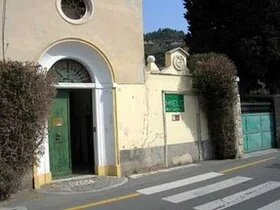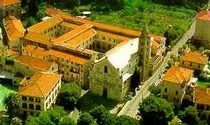clipeo
Documents

Next to the entrance to the Abbey in Via Madonna there is a door (walled up) on the wall of which you can see a metal plate (in a nice bright green) advertising our good NATURAL HONEY. Some people notice, perhaps just in passing, the half figure of the Madonna and Child overlooking the door.
But in 1463 this door was not at all blind (that is, walled up) but was the entrance to the plot of land that now roughly corresponds to the Abbey garden.
At that time, in the vicinity of our sanctuary there was a hospice for pilgrims and the needy (sick, poor or both) and the agricultural products of such a large plot of land could be a real manna.
This Madonnina with Child, surrounded by a Latin inscription that is not easy to read, is called CLYPEUS.
This inscription in gothic characters shows the date of 1463, with the name Viscontina of Bernabé Adorno, wife of Giovanni I Del Carretto.
This sculpture represents the first testimony of the direct intervention of the Marquis Del Carretto, lords of Finale, in our Sanctuary, after the second war with the Republic of Genoa (1447-1451).
The name of Viscontina, daughter of the Genoese Doge Barnaba Adorno, is a small but qualified intervention of the Marquise Viscontina, who prepares the introduction of the Olivetan Benedictines in the church of Finalpia by the eldest son Galeotto II, which will take place under the Bull of Sixtus III , of 20 September 1476.
Thus the real manna became, not the land with its precious agricultural products, but the next arrival of the Olivetan Benedictines in Finalpia.

There are documents that speak of a small nucleus of Olivetan monks already present in Finalpia in 1477, although the actual beginning of the construction of the monastery could only begin in 1491. They were obviously here to explore their new field of work. Their most pressing problem was finding a home where they could settle down and be able to lead a normal life of monastic observance. We said that at our Sanctuary there was a Hospice and, tradition has it, that it was right in the vicinity of where the Apiary stands today. (Excavation works, for building reasons, conducted in the area have revealed the remains of ancient buildings). Furthermore, the austere frame of the entrance to the apiary, which can still be seen today (beautiful work - in local stone - of pure Renaissance style), reveals the entrance to an uncommon house, but which is well suited to a religious house.


